
The best personal blenders for making smoothies and shakes
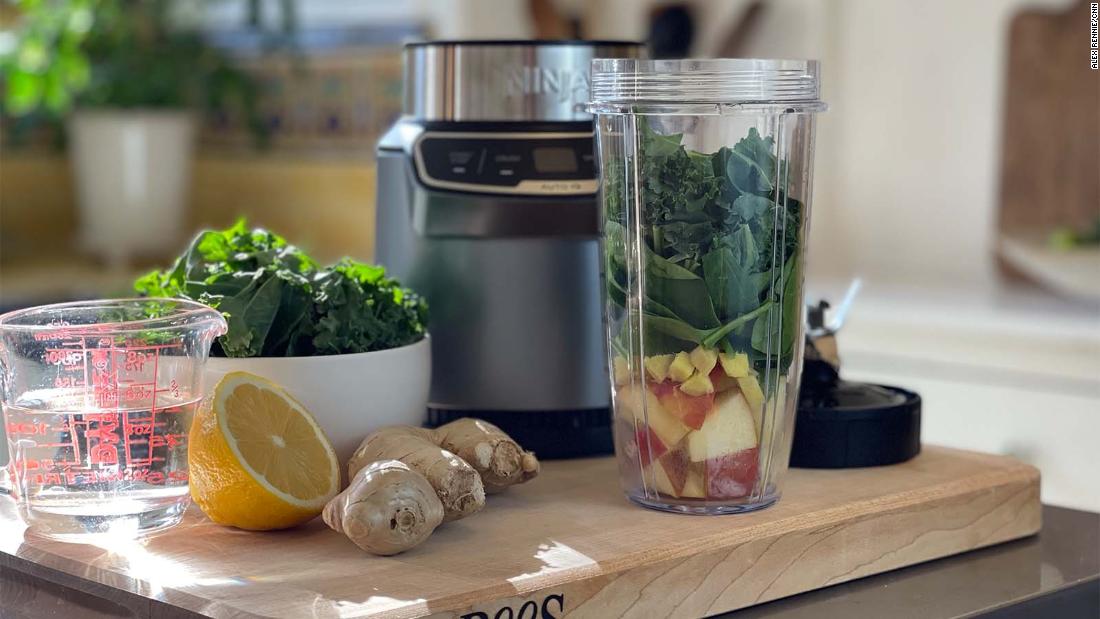
CNN Underscored is your guide to the everyday products and services that help you live a smarter, simpler and more fulfilling life. The content is created by CNN Underscored. CNN News staff is not involved. When you make a purchase, we receive revenue.
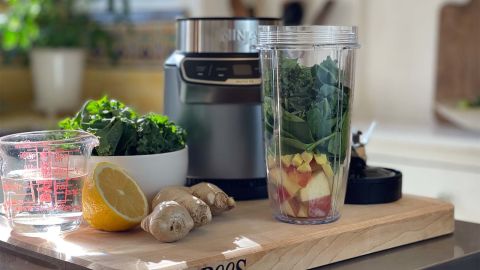
Personal blenders are significantly smaller than their full-size counterparts, and since you can drink out of the cup you’re blending with, they’re great for protein shakes and smoothies. And because their cups feature convenient travel lids, it’s easy and convenient to blend your drink and take it with you to work, to the gym or just to run errands.
We ran nine of the top models on the market through a rigorous testing process, evaluating their ability to execute a variety of blending tasks. We also judged them on their design, construction, and — perhaps most importantly — how convenient and comfortable they were to drink out of.
Best personal blender overall
The clear standout in our testing, the Ninja Nutri-Blender Pro was easy to use, created smooth blended drinks, and included a travel lid that was both comfortable to use and closed securely.
Best budget personal blender
If you don’t require multiple blending modes or settings and just want to make a single-serving drink quickly and easily, the low-cost Magic Bullet Blender is an excellent option.
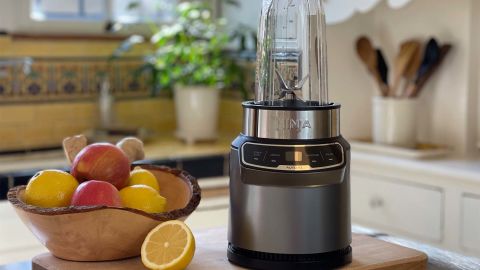
The Ninja Nutri-Blender Pro’s solid construction gives the machine a sturdy, high-quality feel, and the wide base provides a stable foundation for its powerful motor. Its straightforward control panel was the simplest to understand right out of the box of all the personal blenders we tested, making it easy to get right to blending as soon as we plugged it in.
The Ninja Nutri-Blender Pro has dedicated crush, smoothie and pulse modes, but our favorite feature in testing was its Auto-iQ function, which automatically selects a blending and pausing pattern for your chosen mix and stops once the blend is complete. We were initially skeptical of this feature, but ended up being impressed with the results, and appreciated how it let us hit the button once and walk away to do other things, confident we’d get good results. If you’d rather keep an eye on things and stop it manually, you can turn off this function at any time by pressing the “start/stop” button.
The Ninja had no trouble making any of our test smoothies. It easily crushed ice and frozen fruit, pulverized leafy and fibrous vegetables and had no trouble mixing our powdered protein drink in about 10 seconds. Whether this is due to the more vertically oriented blade assembly or to the Auto-iQ blend-and-pause routine, the Ninja also never got “stuck” or needed any manual shaking to clear lumps of partially blended ingredients like some other blenders did.
The travel lid of the Ninja Nutri-Blender Pro was far and away the best of the bunch. It was easy to screw on and the lid cover flips out of the way while you’re drinking, securely snapping back down when you’re not.
The Ninja Nutri-Blender Pro includes two “single-serve” cups, though at 16 ounces they can definitely make two servings. Since it also comes with two travel lids, the Ninja Nutri-Blender Pro can be a great option for a couple or household. The design of the lids, blades and large cups made everything simple to clean, and all the components are dishwasher-safe as well.
Though not a deal breaker, the drawback to the Ninja is its relatively large size compared to the other personal blenders we tried. If you have limited counter space, or don’t have room to store a new appliance in your kitchen, you may want to go with another option, like the Magic Bullet.
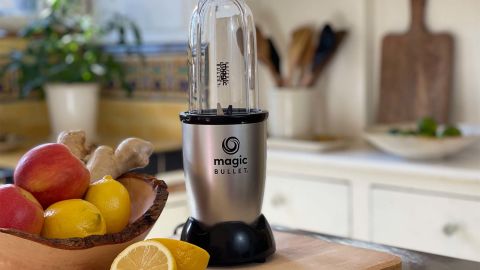
This compact blender couldn’t be easier to use; you just fill the cup, twist on the blade and press it down on the base to activate the motor. This straightforward operation, combined with its small size — about a 4.5-inch footprint — made it one of our favorite options.
Despite its compact size, the Magic Bullet Blender had similar heft and sturdiness to our top pick, the Ninja Nutri-Blender Pro. It performed well in all our tests, although it did take a little longer to reach full blend than the larger, more powerful models we looked at. On our powdered protein drink test, it actually performed better than almost every other blender. Thanks to the small cup size — these are truly single-serving cups — minimal powder stuck to the sides while blending, an annoying issue that some of the larger cups suffered from.
We also appreciated that the Magic Bullet Blender comes with a second single-serving cup, as well as a third “short cup,” so it’s a useful option for more than one person. The cups are easy to clean and won’t take up much room in your cabinet either.
The Magic Bullet Blender’s lids are flat, with an opening like a travel coffee mug, instead of the spouts used by the other blenders we tested. While this design gives the lid a lower profile and makes it secure when transporting, we found it more challenging to drink thick smoothies. This may be a matter of personal preference, but worth noting for those who prefer a spout-style lid.
While the Magic Bullet Blender felt sturdy and featured rubber feet on the bottom to help with stabilization, it did do some slight “walking” across the counter during use. That said, it moved maybe half an inch or so in 60 seconds, so not too big a deal.
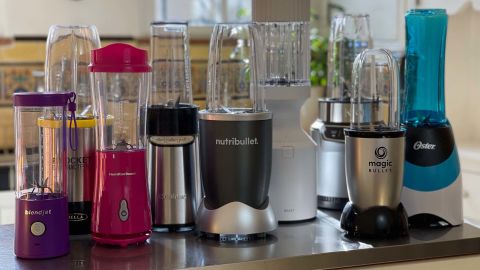
Although these personal blenders look relatively similar, they’re actually more varied than you might think. To help differentiate our options and confidently declare the winners, we tested them across a range of various criteria, from overall operation and ability to blend an assortment of drinks to the usability and security of their travel lids. After testing, we evaluated how each model performed on the following criteria, compared the results and finally chose the two blenders we felt were the best overall.
- User interface/ease of use: We reviewed the instruction manuals and, while operating the blender, noted how easy — or difficult — the blender was to use. Were the controls and user interface intuitive and straightforward, or were they more confusing, requiring some practice?
- Versatility: How many blending modes did each unit offer? More doesn’t always mean better, but it’s good to know, especially if you know you are interested in a specific mode, like “pulse” or “low.”
- Operation: How powerful was the motor? How quickly did the blades crush, blend or mix the ingredients in the cup? Did the blender struggle and need you to manually shake it to work effectively?
- Frozen berry drink: We filled each cup with a mixture of ice, frozen berries, half a banana and half an apple and evaluated each blender’s ability to crush the ice and blend together the rest of the ingredients. We then judged them on the completeness of the blend as well as the final texture.
- Green smoothie: We filled each cup with kale, spinach and ginger root chopped into half-inch pieces, water and ice, and evaluated the blender on its ability to process the hard and fibrous ingredients. We also judged them on the completeness of the blend as well as the final texture.
- Protein shake: We filled each cup with protein powder, almond milk and ice, evaluating the blenders’ ability to quickly and completely mix the wet and dry ingredients together. We paid close attention to any remaining powder chunks after completion and remnants stuck to the sides of the cup.
- Build quality: Right out of the box, we paid close attention to the blender’s sturdiness and durability. Does it feel flimsy or cheap, or heavy-duty and durable enough to last? Do its components and buttons feel cheap, or made from high-quality materials?
- Stability: While in use, does the blender stay securely in place, or does it wander or vibrate across the counter? This is especially important when it comes to taller blenders with narrow bases.
- Lid quality: A reliable and secure lid is one of the biggest factors to consider when it comes to personal blenders, and we thoroughly tested each one to make sure it was comfortable to drink out of as well as secure enough to prevent spills and leaks while traveling or just walking around the house.
- Accessories: Did the bender include any extra accessories or items like additional blades, shaker lids or cup sizes? These are less important when it comes to personal blenders — we didn’t judge them on their ability to do things like blend nut butters or grind flour, tasks better left to larger, more powerful models — but still worth noting.
- Capacity: How much liquid can the cup hold? Is it too large to be convenient for travel, or too small to be useful?
Maintenance
- Ease of cleanup: How easy was the unit to clean overall? Were the blades difficult to access, was the lid easy to wipe down and were there any design elements of the cup that made them particularly easy or difficult to keep clean?
- Dishwasher safety: Can the cup and lid be washed in the dishwasher? Blenders are notoriously hard to clean, especially when they are allowed to dry, so this is an important consideration.
- We also noted the length and specific warranties of each blender and the types of coverage they offer.
Who needs a personal blender, and why?
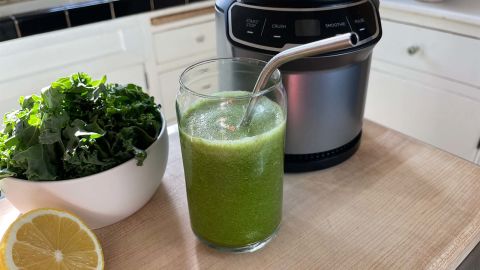
The diminutive size of personal blenders, compared to full-size models with large pitchers, makes them a convenient and useful appliance for those who are most interested in making single-serving drinks with minimal cleanup.
With single-serving cups and locking travel lids, they are a great choice for those who want to take their smoothies on the go, whether that’s to the gym, class or work. They’re perfect for protein shakes and smoothies, sports drinks and on-the-go meal replacements.
Even if you’re not headed for a workout, they are a cost-effective solution for anybody who would otherwise be buying smoothies or green drinks from a smoothie shop. The relatively low price of personal blenders — our top picks are $100 or under — makes them even more attractive.
Plus, their compact size makes them great for those who don’t have the extra counter space that larger, bulkier blenders would require, and need something small enough that it can easily store away in a cupboard if needed.
While they can’t necessarily do everything a larger blender or food processor can, personal blenders can be used to make a variety of other items. Depending on the power of the unit, they can make satisfying salsas, soups and purées, and a few of the models we tested come with a separate blade for chopping and mixing dry ingredients and can be used to grind up flaxseeds and herbs, and even masticate nuts for nut butters. Salad dressings and condiments like mayonnaise, ketchup or hummus can also be made with most personal blenders. If you’re not sure if a blender has the power or blending mode to make a specific item, you can usually download the user manual online before purchasing.
NutriBullet Original ($42.27, originally $59.99; amazon.com)
The heavy-duty feel and sturdy construction of the NutriBullet Original make it a great choice for anyone who prioritizes performance over portability. Its powerful motor handled all our testing with ease and quickly blended anything we put inside the cup. The simple operation was easy to use as well. With no settings or controls to mess with, you just screw on the blade to the cup, flip it over onto the base and press down — immediately activating the blender. The NutriBullet Original performs similarly to the Ninja Nutri-Blender Pro, but its lid isn’t as good, so it isn’t as well-suited to making drinks for on the go.
Even though it was comfortable to drink out of, the latch that covers the spout wasn’t as secure as the Nutri-Blender Pro’s. That being said, if you’re planning to use it around the house and you’re fine drinking smoothies and drinks right out of a lidless cup, this blender could be a good alternative. And its relatively low price makes it an attractive choice for those on a budget.
Hamilton Beach Personal Blender ($19.99, originally $20.99; amazon.com)
You won’t find a cheaper personal blender than this Hamilton Beach model. Its single-button control is convenient for anyone who wants to avoid the extra hassle of multiple settings and the lightweight design makes it easy to pick up and shake around any ingredients that aren’t “catching” the blade as you’d like. Unfortunately, we ended up doing this quite a bit during our testing, as the small blades had trouble with the ginger and kale of our green smoothie. The design of this blender also permanently connects the blade assembly to the cup, which makes cleaning inconvenient if you take it to work or the gym. If you’re not able to wash it until you arrive back home, your dried ingredients can be a real challenge to scrub off. The entire unit is dishwasher-safe so this isn’t the end of the world, but it isn’t a great solution. The lid was both tough and messy to remove, and our least favorite among the blenders we tested. Instead of screwing on, you have to press the lid down and snap it into place, which also ended up spilling some of the contents.
Oster My Blend ($29.99; amazon.com)
Despite its powerful motor and sizable blades, the Oster My Blend’s odd-shaped cup made it impossible to make it a favorite. Unlike the other, more-tapered cups we tested, its cup narrows in the middle, which makes for easy gripping, but creates an annoying bottleneck for ingredients to get stuck while blending. The cup is also a blue color, which makes it difficult to see whether ingredients are mixed in well while you’re blending — a particular challenge with protein powders.
We appreciated other design features, like the carrying handles on the lid and the motor base, as well as the comfortable drinking spout. The Oster does have a powerful motor, blending ingredients easily — so long as they were able to reach the blade. Cleaning wasn’t easy either, and without a long bottle brush, you’ll have trouble getting to the bottom with a sponge — though it can go in the dishwasher.
BlendJet 2 ($44.99, originally $49.99; bedbathandbeyond.com)
We had high hopes for this ultra-compact blender, and although its cordless design is interesting, and potentially convenient for some users, we weren’t fans. It charges via USB, which means you don’t have to worry about plugging it in, but it does require you to carry around the entire unit (both the cup and motor base) if you decide to take it anywhere. We found this to be a safety issue, especially when we accidentally pressed the power button to activate the blade while we were drinking out of it. Although this can be remedied by using the lock setting — you press the power button until the purple ring flashes three times — it doesn’t feel intuitive for the user. We’d like to see a separate lock button or switch, although this would obviously take away from the single-button design.
In terms of performance, the BlendJet 2 had some trouble with our leafy vegetable drink, though it may have been due to the size of the greens we used. With better-chopped kale and smaller ginger chunks, it probably could have handled the drink better. But when it came to frozen berry and protein powder drinks, the blender did an admirable job. The carrying strap on the lid was a nice feature, and though it didn’t offer a spout or sipping opening, it stopped leaks and spills by securely screwing on tight.
Cuisinart CPB-300 (starting at $39.99; amazon.com)
This is a great blender, we just didn’t think it was a great personal blender. An extremely powerful option, it comes with four drinking cups (including an extra-large 32-ounce pitcher) and an additional blade for chopping, and is simple to use, with a “high,” “low” and “pulse” settings. Unfortunately, what it doesn’t provide is a decent travel lid for drinking on the go, which is an important criteria for a personal blender.
The four included lids all have drinking spouts, but they aren’t secure enough to stay on for travel, and the fifth lid, although it screws on securely, isn’t convenient for casual sipping. All this being said, if you aren’t bringing your blended drinks anywhere or don’t mind transferring them to a different receptacle, the Cuisinart CPB-300 could be a great choice. The inclusion of the extra-large pitcher allows it to work as a full-size blender and the chopping blade increases the variety of ingredients you can blend and the recipes you can make.
Bella Rocket Extract ($59.99; amazon.com)
This ultra-powerful blender couldn’t be simpler to use, and as with the NutriBullet, you press the cup down to activate the blades. It comes with an impressive amount of accessories — including five different cups and a pair of blades — so like the Cuisinart, it could be a good choice for a full-size blender-style option. It also handled all our testing well, and absolutely pulverized anything we put inside the cup.
The large cup, at 23.6 ounces, is big for single servings, but a bit small for traditional blender duties, and when we tested it with our protein shake we ended up with powder stuck to the sides. We didn’t like the Bella Rocket Extract’s travel lid, which didn’t have an ergonomic spout and wasn’t as comfortable to drink from as our top picks, though it was watertight and secure. Still, it was a close call, and a better-designed lid would have made this one of our top choices.
Beast Blender ($155; amazon.com)
The Beast Blender is a gorgeous device, with a far more stylish build than the other models we tested. The fluted, ridged oversized cup has a twist-on cap with a carrying handle, and was probably the most overall secure lid we tested. The white base and cup accents were attractive and we enjoyed the single-button control, which provided two modes — pulse and blend. The blend mode is a 1-minute timed cycle, which is made up of three blending periods separated by two pauses to allow for the contents to settle. However, it wasn’t as effective as the Ninja blender’s similar Auto-iQ function.
Unfortunately, the Beast is not dishwasher-safe, and washing by hand is inconvenient because the ridges on the inside of the cup, although they look good, make it a challenge to clean, especially if you’ve left it in your bag all day and the contents have dried on. All that being said, if you are looking for a more design-forward blender, you’re not going to do any better than the Beast Blender.
Read more from CNN Underscored’s hands-on testing
Note: The prices above reflect the retailers’ listed price at the time of publication.
Sign up for our newsletter
By subscribing, you agree to our privacy policy
Source: https://www.cnn.com/2022/01/06/cnn-underscored/best-personal-blender/index.html?iid=CNNUnderscoredHPcontainer

















